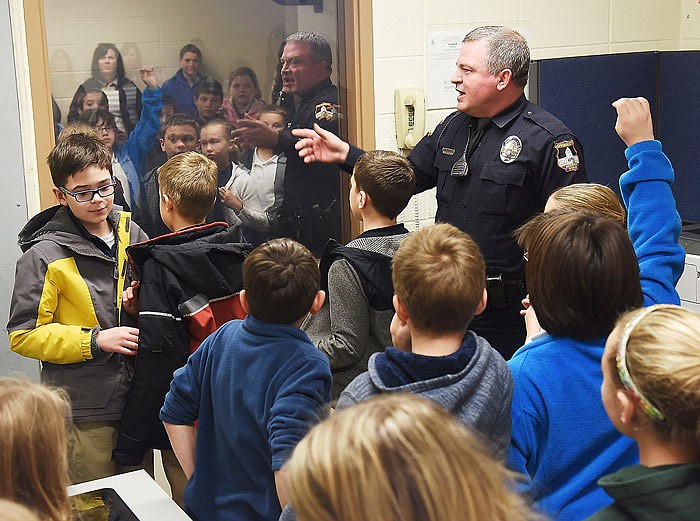"Best field trip ever" is what Jefferson City Police Department Officer David Mays said he overheard Monday, when all three fourth-grade classes from St. Joseph Cathedral School stopped by JCPD headquarters as part of their Catholic Schools Week activities.
The students got an extensive tour of the the police station, and also brought thank you notes for officers.
"It shows that kids respect what we do," Officer Les Martin said.
"(The cards are) not addressed to one, but to all," Martin said, and he added he would put them in the station breakroom, where everyone including the chief can see them.
Martin is a school resource officer (SRO) - "in charge of all the (public) elementary schools" in the area, Mays said.
Mays is also an SRO with Lewis and Clark Middle School.
Even inside the station, officers still are in a school of sorts.
"Yes, we have to go to class," Mays told students as they started their morning in the room where officers complete their annually required hours of continuing education.
About 40 students and a dozen teachers and family chaperones listened as Mays and Martin explained things involved with police work - including Tasers.
There were groans among the students as Mays explained Martin would not be taking his Taser out of its holster.
However, Mays did show one of the barbed darts that fires out of a Taser - "like a fishing hook," he said.
The darts are designed to lodge into the body of a suspect and conduct electric current from wires that connect back to the weapon. The weapon is intended to be incapacitating but non-lethal.
Mays explained the feeling of being tased to the students as like someone dragging their feet across carpet and then touching them - only unlike a quick shock of static electricity, the Taser's burst of energy is continuous for a few seconds.
"Once the threat has stopped, you stop," he said of the guidelines for the use of force when it comes to deploying a Taser.
He didn't want to let the fact that officers have to be tased during their training discourage any would-be future candidates in the audience.
"I highly encourage some of you girls" to join the force, Mays said. "I know you girls are tough enough, too."
Mays went on to explain the core of police work. "It's unfortunate sometimes, but people make bad decisions, and we have to arrest them."
"We investigate those crimes, and we find out who did it," he said, emphasizing that "our No. 1 job is to help people."
Mays explained more mundane aspects of police work, too - daily briefings of what to look for in patrol zones, including addresses of homes to watch over while people are on vacation.
There are also some stereotypes. "When I'm in uniform, I don't eat doughnuts," he said.
Mays and Martin hope giving students an insider's look at law enforcement will instill in them images of officers who go beyond only threats of punishment.
Martin also explained that students who go on into the public school system will need to know how to interact with officers because they will see them on a daily basis as SROs.
"We're not there to take kids away to jail," he said, but to keep them safe.
Though he warned students that punishment for crimes is "no longer just time out" when they grow up, "I'd much rather sit and counsel people than take them to jail," Mays said.
After their version of a morning briefing, students were shown around the station.
Fourth-grade teacher Brandy Prenger said the students "really enjoyed the call center," which she found interesting, too. The call center is where dispatchers receive and relay communications, including emergency calls.
Another stop was the evidence room - which had the strong "skunk" smell of seized marijuana - where Mays explained how evidence is obtained, sealed and verified for investigations and court proceedings.
There's more than one evidence storage area. Given that JCPD responds to close to 60,000 calls a year, Mays said, "50-60 percent our basement is dedicated to evidence," he said.
Another stop on the tour was the area where arrested suspects are processed - searched for weapons, interviewed to gather intelligence, interrogated to obtain a confession or breathalyzed if need be.
It's clear what the favorite stop on the tour was for many students.
"I think I'm going to be a member of the SWAT team," Prenger said of what she overheard some boys in her class saying once they got back to school.
SWAT Sgt. Jason Payne showed the students some of the tactical gear SWAT team members use when they deploy - body armor, shields and battering rams to smash through doors.
Outside the station, another group of students got to see traffic unit Officer Jason Sederwall pull up on his motorcycle - a modified 2016 Harley Davidson Road King.
"It weighs about 950 pounds without me on it," Sederwall said.
He explained his training and experience to the fourth-graders. He said he spent two weeks learning how to ride the motorcycle in every road or off-road condition - except ice and snow, which make conditions too hazardous.
"I like to ride in parades," he said, adding he's also helped escort presidential and vice-presidential candidates when they visited the area - Sen. John McCain; former Alaska Gov. Sarah Palin; then-Sen. Barack Obama; and then-Sen. Joe Biden.
Per their schedule for Catholic Schools Week, St. Joseph Cathedral's kindergartners visited Jefferson City Fire Department's station No. 3 to thank firefighters for their service.
Fifth-graders read to children at Jefferson City Day Care, sixth-graders entertained residents at St. Joseph's Bluffs Lutheran Senior Services, and seventh- and eighth-graders entertained residents at Oak Tree Villas senior living community.

